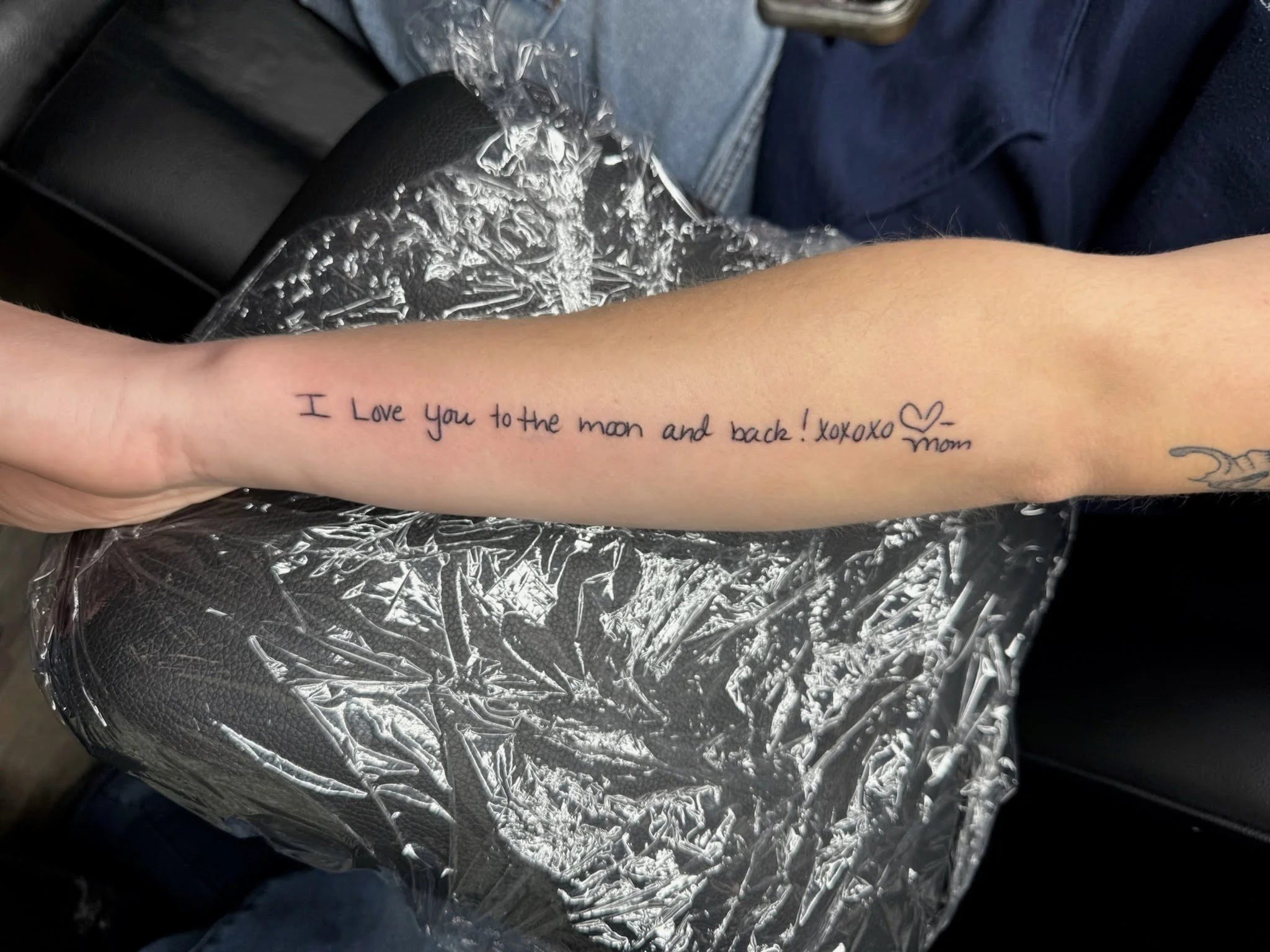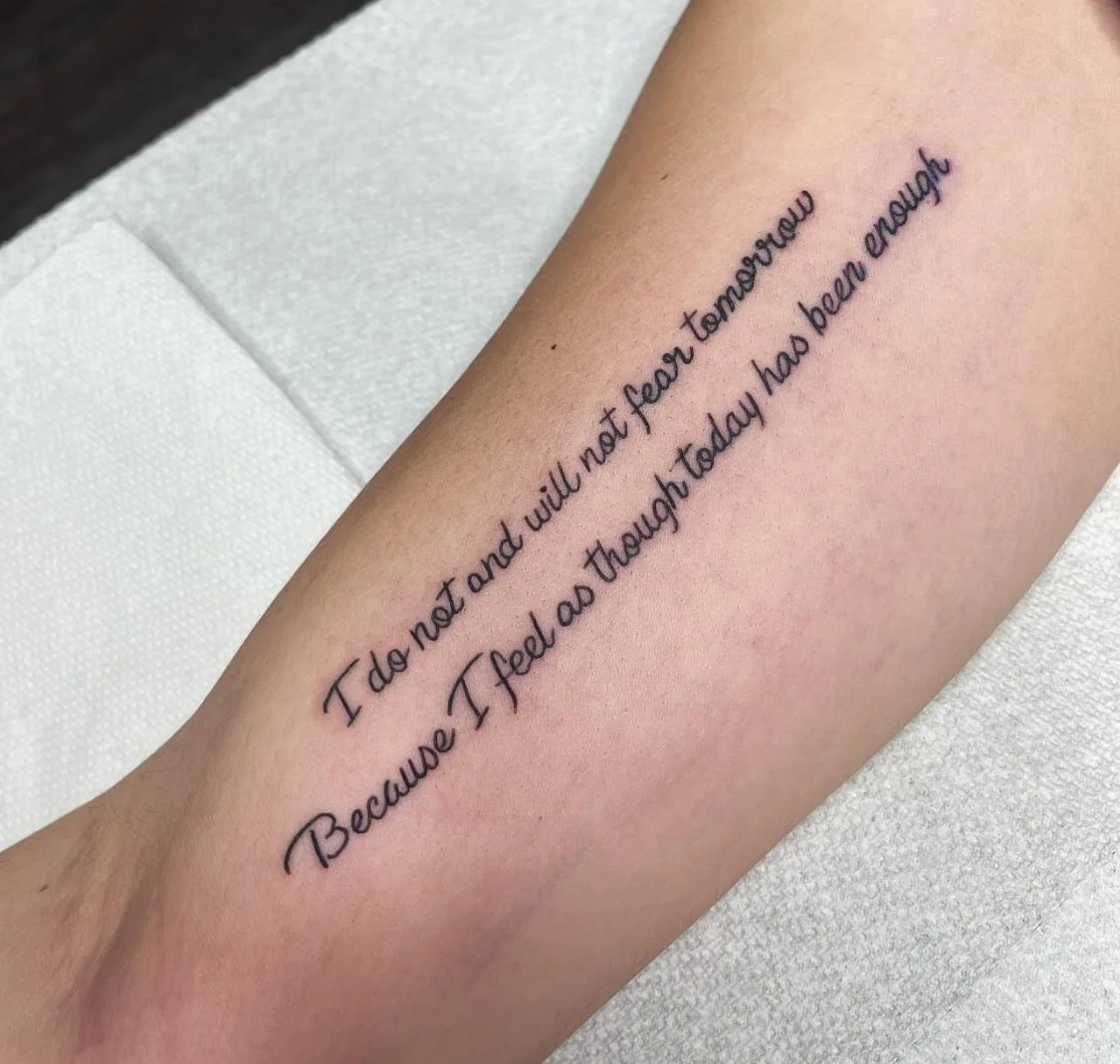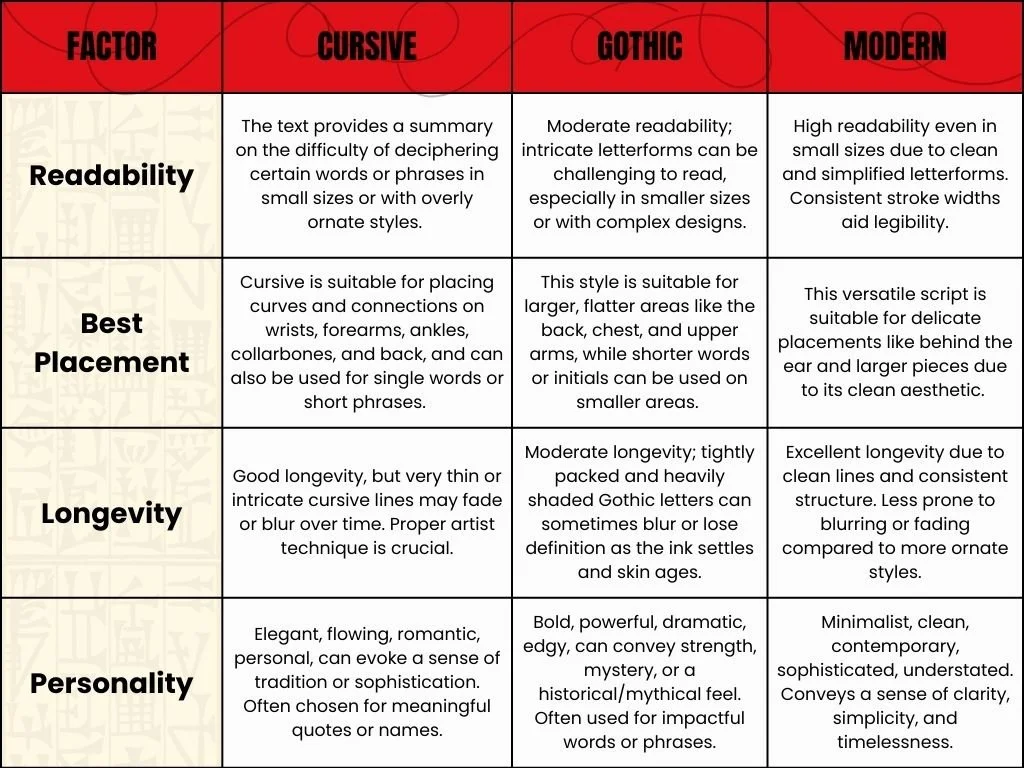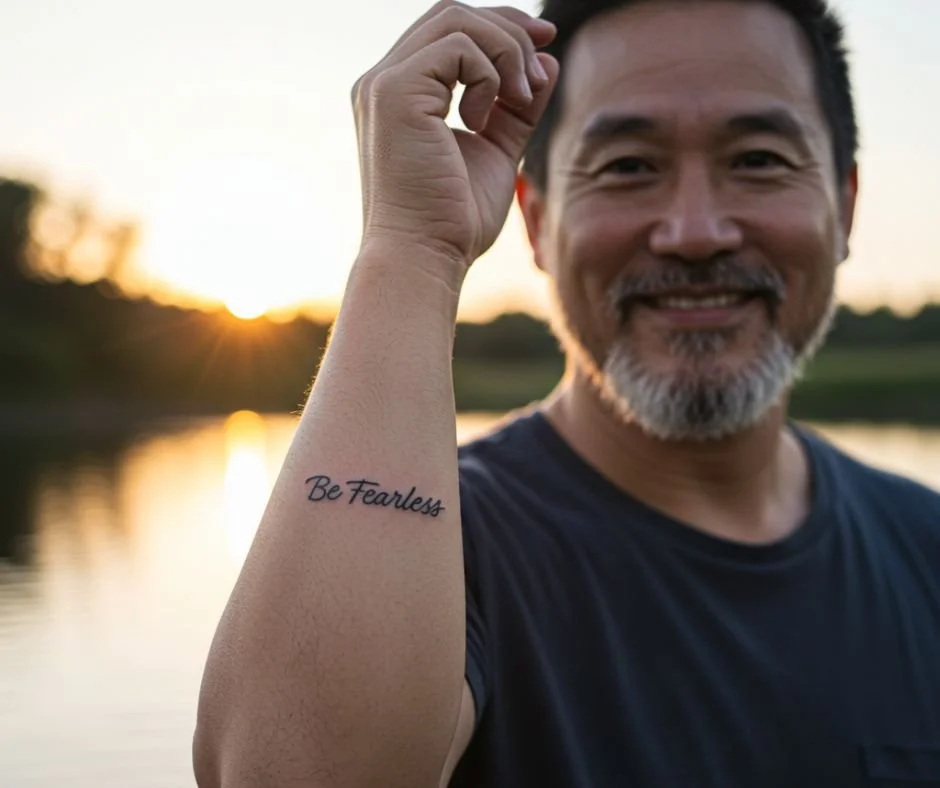How to Pick the Perfect Font for Your Script Tattoo
Most people think getting a script tattoo is about choosing the right words. It’s not.
It’s about whether you want those words to look like a love letter... or a lost lawsuit.
Because fonts talk. They whisper personality, scream mood, and sometimes—accidentally—mumble something that makes your ink look like a high school yearbook signature. Permanent. Sloppy. And utterly misread. (Yes, there’s a guy who lived five years thinking his wrist said “resilience” when it actually read “residence.”)
This isn’t about style. It’s about control. The font you choose for your script tattoo doesn’t just shape how your ink looks—it warps how it feels. To you. To them. To everyone who locks eyes with that one line you paid to carry your soul.
And that should never be a coin toss.
Understanding Script Tattoos
You’d think a script tattoo would be hard to mess up. It’s just words, right? A quote. A name. Maybe a verse that got you through hell.
Except — this one’s tattooed on your actual body. Forever. And the difference between “timeless” and “public typo” is about three seconds of font indifference.
Script tattoos are often used for personal declarations — names, Bible verses, song lyrics, ancient Greek, Arabic calligraphy, or that one line you swore you’d never forget (until you did, and had to get it inked). They look deceptively simple. A few swirls, some spacing, job done. But beneath that simplicity is a cocktail of emotional weight, linguistic nuance, and technical risk.
People don’t just pick these tattoos for aesthetics — they pick them for meaning. Which is why it’s frankly wild that so many get stamped in fonts for script tattoos that have all the soul of a printer test page.
Let’s be blunt:
Some fonts look amazing in Photoshop mockups and disintegrate into smudged spaghetti once they hit skin.
Others are “trendy” now but have the visual lifespan of a fast fashion hoodie.
And then there’s the wildcard — the completely illegible script fonts tattoo lettering that your mom swears says “perseverance,” but your barista keeps reading as “passenger.”
You’re not just tattooing a phrase. You’re tattooing how people feel when they read it. That’s why your tattoo script font choice deserves more than a scroll through the first three Pinterest boards. It deserves some damn thought.
Key Factors to Consider When Choosing a Font (AKA How to Not Hate It Later)
Choosing a script tattoo font without asking a few hard questions is like getting married in Vegas — exciting in the moment, hard to justify in daylight.
Let’s break it down:
Readability: Will You Still Know What It Says in 2035?
Small script tattoos are cute. Until they age like milk.
If your font is too delicate, overly loopy, or designed for calligraphy competitions instead of human skin, it will blur. Not if — when.
Pick a tattoo script font with clear, spaced letters. Pay attention to kerning (that’s the spacing between characters) — it's not just a designer’s concern; it’s your skin’s concern now.
Style and Personality: Fonts Have Vibes — Use That
Fonts talk.
A sleek, slanted cursive might say “elegant and mournful.”
A jagged blackletter might scream “I learned Latin in a mosh pit.”
The font should match the emotion, not just the aesthetic. Don't slap a wedding vow in something that looks like it belongs on a 1980s horror poster. Be honest about the message and match the tone. There’s a reason professional ink designs lean into style-personality pairings that feel intentional.
Longevity: Your Skin Will Stretch. Your Tattoo Will Too.
Let’s not pretend your script tattoo will stay frozen in time. It won’t.
Skin softens. Lines spread. Your “a” might turn into a mutant “e.” That Instagram-ready cursive could become the visual equivalent of mumbling.
Fonts for script tattoos that last tend to have:
Moderate-to-thick strokes
Low decorative excess
Smart spacing
Basically, they’re built for skin, not screen. If you’re working with a talented artist, ask them what fonts age like wine… and which turn to soup.
Placement: Skin Isn’t Flat — Fonts Need to Flex
Where you place the tattoo directly affects how it reads.
The wrist, for example, is a skin rollercoaster. Ribs expand. Ankles stretch. And if you go too small on a finger? Prepare to watch it vanish in under 18 months.
Small script tattoos have to be brutally practical — no fine loops, no hyper-stacked ligatures, no ornate spacing that’ll melt with movement.
Your artist is laying text across a living, moving, shape-shifting surface. That’s why professional ink designs factor in anatomy just as much as aesthetics.
Step-by-Step Guide to Picking the Perfect Font
You’d be amazed how many people spend three days choosing an oat milk brand but pick a tattoo font in 45 seconds.
It shows.
If you’re serious about inking words into your skin — forever — you don’t need a moodboard. You need a method. And a grip on reality. This is that.
Step 1: Define What the Tattoo’s Actually For
If you can’t answer this in a full sentence, stop.
What’s the reason behind it — a quote? A death? A date you refuse to forget?
Don’t start picking tattoo script fonts until you know what you're actually saying and why it needs to live on your body.
Script tattoo ideas that land tend to come from a place of clarity — not impulse.
Step 2: Research Font Styles
Let’s not pretend all fonts are the same. Some look poetic. Some look like gas station receipts.
Cursive: Emotional. Elegant. Can easily slide into the “can anyone read this?” zone.
Gothic: Bold. Structured. Makes short words hit harder, but can get dense real fast.
Modern: Minimal. Geometric. Often used when you want your message to be heard, not interpreted.
Cultural: Greek, Arabic, Devanagari. Deep history. High risk if used without context or understanding.
You’re not picking a mood — you’re picking a tone that has to last through skin shifts, personal growth, and bad lighting.
Step 3: Test with a Tattoo Script Font Generator (But Don’t Get Fooled)
Yes, online tools like Font Meme or Tattoo Font Generator are helpful. Use them. Screenshot every version. Then stop assuming the screen knows better than your artist.
A tattoo script font generator is great for previews — but none of them account for elbow wrinkles, weight fluctuation, or natural skin tone contrast. You can’t 3D print this on your arm.
Generators are a starting point. Not a verdict.
Step 4: Test for Scalability and Placement (Because Your Skin Doesn’t Stay Still)
Tattoo it too small and that delicate quote you loved becomes the ink equivalent of a whisper in a wind tunnel. Small script tattoos fade faster, and stretch weird on mobile areas like fingers and ribs.
Also, the placement of your ink affects how the font performs.
Wrist tattoos? High traffic, constant sun exposure.
Ribs? Painful, stretchy.
Inner bicep? Great visibility, less friction.
If your font doesn’t work in that space, it doesn’t work at all.
Step 5: Consult an Actual Tattoo Artist (Not Your Group Chat)
Text tattoos are one of the highest-regret categories in the game. Half of that comes from people treating tattooing like printing — straight from app to body.
An experienced artist knows how certain tattoo script styles heal, fade, blur, and bite back. They’ll tell you whether your spacing makes sense, whether that letter “Q” is going to age like fresh paint or like spilled soup.
If they raise an eyebrow — listen. That’s not judgement. That’s insurance.
Step 6: Don’t Hit Go Until You’ve Reread It (Aloud, Sober, and Slowly)
People still get “no regerts” tattooed on their ribs. It happens.
So this part matters. Reread the phrase. Say it out loud. Look at it in the mirror. Ask someone who doesn’t love you enough to lie. Are the letters readable? Does it still give you that feeling it gave you when you wrote it down the first time?
Creative ideas for meaningful tattoos deserve double checks, not do-overs.
Popular Script Tattoo Fonts and Styles (Read This Before You Ink Something from Microsoft Word)
There are fonts that exist to make things beautiful. There are fonts that exist to make things clear. And then there are fonts that exist to wreck tattoos.
These ones below have actually worked — on real skin, in real designs — and they don’t require a decoder ring to make sense of them.
Cursive Fonts (Use With Restraint)
Great Vibes — Pretty without falling into Instagram cliché. Good balance of readability and movement.
Alex Brush — Polished, classic, thick enough to survive five summers.
Cursive’s great — until someone gets too excited with the loops. Use it when you're going for soft emotion, not drama club energy.
Gothic Fonts (Best in Small Doses)
Old English — Strong and historical. Great for initials, not for full sentences.
Blackletter — A style you respect or regret, depending on usage.
Great for single-word tattoos with impact. Not ideal for long memorial passages — unless you’re okay with people misreading half of it.
Modern Fonts (Minimalist, but Not Boring)
Helvetica Neue — Functional, clean, brutally honest.
Futura — Efficient, easy to scan, no-nonsense.
Modern fonts work when you want the words to speak for themselves — no flourishes needed.
Cultural Scripts (Deep Meaning, So Handle With Precision)
Greek Script — Authentic if it’s tied to heritage. Don’t fake fluency.
Arabic Calligraphy — Graceful and deeply symbolic. Requires understanding, not guesswork.
These fonts carry centuries of context. If you don’t know the weight behind the language, research before you ink. Respect beats trend.
If you’re still thinking, “I’ll know the right font when I see it,” you probably won’t. Fonts don’t beg for your attention. The right ones feel right, look right, and hold up under scrutiny.
And if your artist says it’ll blur in five years? Believe them. Skin doesn’t lie.
Tips for a Script Tattoo That Won’t Make Future You Cringe
There’s nothing charming about a tattoo that looked smart on day one and broke your heart by year three. That’s the problem with letters — they either age with grace or drag your dignity down with them. And no, "just touch it up later" isn't a reliable plan.
Pick an Artist Who Actually Knows Lettering
Not every tattooer who’s good with snakes and skulls is qualified to lay down script font styles for tattoos. Lettering requires different muscle memory. Different pressure control. And, most importantly, restraint.
Some studious specialize in this for a reason — getting lines to heal consistently at that size is technical skill, not a Canva hobby.
If your artist isn’t regularly producing script letters tattoo work that holds up for years, find one who does.
Complexity Kills Clarity
This isn’t a wedding invitation. It’s ink on skin. And skin shifts. Don’t pick a font that looks like it came from a wedding invitation in 1896 and expect it to still read clearly in 2040.
If your cursive tattoo designs are hard to decipher even on paper, you’ve already lost. Strip it back. Let the message breathe.
Skin Tone and Ink Color Aren’t Optional Details
Contrast matters. Black ink reads differently on pale vs. dark skin tones. Fine lines behave differently on melanin-rich surfaces. This isn’t about preferences — it’s about physics and visibility.
If you don’t adjust your font weight or line thickness to match your skin, it can go faint, fast. And don't pretend color choice doesn't count — certain hues fade faster, especially on exposed areas like arms and wrists.
Keep It Alive (Or Watch It Fade)
Sun, dehydration, and dry skin are the unholy trinity of tattoo decay. If you want your bible script tattoos on arm to remain legible, sunscreen and moisturizer aren’t optional. They’re non-negotiables.
Aftercare is like editing. The tattoo is the raw file — how it ages depends on what you do with it.
Fonts Are Forever. Regret Shouldn't Be.
You can wear bad pants for a season. But a bad script tattoo stays with you through birthdays, breakups, and possibly your child’s graduation photos.
Choosing the right font isn’t a “design preference.” It’s a long-term communication decision — one that affects not just what your tattoo says, but how it’s heard.
You’re working with living tissue. With time. With meaning. If that doesn't deserve careful thought, nothing does.
So take your time. Ask questions. Test it. Reject fonts that don’t hold up under pressure. Talk to someone who knows what healed script actually looks like a decade later. At Burned Heart Tattoo, we’re not just here to lay ink — we guide people toward work they won’t hate five birthdays from now.
If you’ve been circling fonts, phrases, or script tattoo ideas — we’d rather help you make the right choice now than fix a rushed one later.
Send us what you're working with. Bring us your quote. Ask the awkward questions. We'll help you make it make sense.
Because no one ever came back grateful their tattoo was “fast.”
They come back grateful it was right.
Frequently Asked Questions
-
A: Script in tattooing refers to any tattoo that uses stylized lettering or handwriting-inspired fonts to display words, names, or phrases. It includes various script font styles for tattoos like cursive, gothic, or calligraphy, and is often chosen for its emotional weight and personal significance.
-
A: The semicolon tattoo is a symbol of mental health awareness and suicide prevention. It represents a pause rather than an end—often chosen by individuals who’ve struggled with depression, trauma, or suicidal thoughts, as a reminder that their story isn't over.
-
A: The best script for tattoos depends on legibility, longevity, and personal tone. Fonts like Alex Brush or Great Vibes are popular for cursive tattoo designs, while simpler styles are better for small script tattoos or high-motion areas like wrists or ribs.
READ MORE…
Different Tattoo Styles Explained: Find Your Perfect Ink







